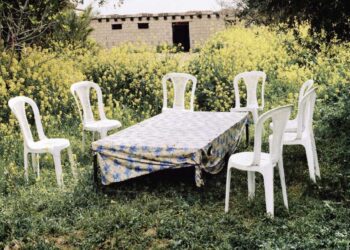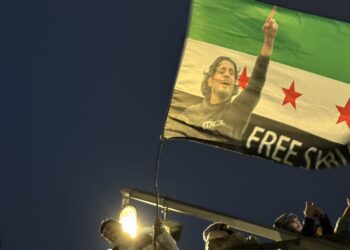In just a few hours, two Israeli airstrikes obliterated landmarks that embodied centuries of southern Lebanon’s rich history. The region, known as Jabal Amel, has long been associated with its deep-rooted, predominantly Twelver Shia Muslim community, considered one of the oldest such communities in the world. This mountainous area, with the Litani River running through it, overlooks the Mediterranean Sea and connects to Mount Lebanon, Wadi al-Taym, and the Beqaa Valley.
These attacks are not merely about claiming lives; they aim to erase the roots, culture, and livelihood of the people in both Lebanon and Palestine. This is not collateral damage — it is an intentional strategy to wipe out the soul of the land, its history, and its people.
But as thousands are killed and wounded in Israel’s ongoing genocide in Palestine and brutal attacks on Lebanon, the urgent need to save lives and cope with trauma often overshadows the devastating loss caused by the systematic destruction of heritage, memory, and history.
The heart of the south
One of the countless victims of this campaign was the historic market in Nabatieh, Jabal Amel’s largest city and a bustling center of life and commerce for generations, with buildings and shops older than Israel itself.
Nabatieh has long been a commercial and cultural hub for a region that historically connected Jordan, Palestine, Syria and southern Lebanon, a meeting point where merchants and travelers would gather, exchanging goods and stories, keeping alive the cultural and economic lifeblood of the region.
The market’s destruction is not an isolated incident but part of Israel’s longstanding strategy of targeting cultural landmarks, reflecting a colonial desire to erase the roots and memories of the people who inhabit these lands.
سوق النبطية قبل وبعد 💔 #لن_نركع pic.twitter.com/XQl0XNwU4G
— 𝓗𝓲𝓼𝓱𝓪𝓶 (@Hisham10452) October 13, 2024
Translation: Nabatieh market, before and after. We won’t submit
According to Kamel Jaber, a local journalist who has long documented the history of his beloved city, “The destruction is so complete that it renders the souks irrecoverable. Since 1975, we have been gradually losing our heritage due to Israeli attacks, and each time, the response has been to rebuild something modern, not to recreate the old as it was.”
Countless people took to social media to document the faces and stories of this ancient market, among them Badia Hani Fahs, who wrote:
Translation: Nabatieh’s heart has burned … Here was the Dimasi sweets shop, the one that left Sidon long ago and settled in Nabatieh. Just a few months ago, they did a new renovation and had a fresh start. Next to it was Kamel Jaloul’s shop, my cousin, the first men’s shoe store in the market. No groom went to his bride without wearing shoes from Jaloul. On the corner was the Hijazi bookstore. We all bought our bags and school supplies from there for ourselves and our children. When we were young girls, we used to borrow second-hand novels for just a few liras. Across from it was Studio Al-Amal. You’d walk in to see Al-Husseini and find photos that are 60 to 70 years old, pictures of your grandparents and their friends. A bit further down was Baalbaki Pharmacy, run by the family who came as refugees from the Beqaa Valley. Their origins are from the Alou family, but they were given the Baalbaki name, which became their family name. Turning left, we’d come across the pride of Nabatieh’s industry, Sultan Sweets. The smell of cleanliness, fresh cream, and extra crispy kunafa would fill the air. You couldn’t enter without being offered a sweet and a sip of water. Continuing on, we’d pass Farol Bookstore, owned by the kind Rafaat Hatit, who fled from Kfeyoun during the Mountain War and settled in Nabatieh, keeping the same bookstore name. Across from the bookstore were the two most important shops in the market, run by two remarkable women: Hasiba, Umm Rami Al-Amin, and Maha, wife of the activist Afif Qaddih. Next door was Al-Mashaal Spices, owned by Ali Batata. Going uphill, you’d find Arnout’s Falafel, the most famous falafel shop in all of the South. Arnouti was originally Albanian, and he lived in Akka, where he learned the craft of making falafel. After the Nakba, he came to Nabatieh, bringing his trade with him, and with every attack on Nabatieh, he was hit by another disaster. Beside him was Mukhtar Hassan Jaber’s shop, which he inherited from his father, Nizar Jaber. This was the shop where you’d find anything you needed. Those who didn’t know Nizar Jaber had never seen love and kindness embodied in a man. On the other side was Disco Al-Sha’ar, which made the market dance to the latest music trends from east to west. This is our heart that burned, not just a block of concrete.
Ancient olive trees, historic markets, and entire communities — these are not just casualties of war but deliberate targets in a campaign to deny the people their heritage and identity.
Ancient trees, deep roots
Hours after the destruction of Nabatieh’s market, another Israeli airstrike hit the neighboring town of Mayfadoun, obliterating the Rtail family home known for its ancient Mount Tabor oak which has stood witness to the region’s history for centuries and is locally known as the Maloula tree. Towering at over 18 meters (59 feet) with a five-meter (16-foot) trunk, the Maloula tree is more than a natural relic. It holds cultural, historical, and personal significance.
According to local tradition, the tree has always been there. In 1995, Abu Rashid Rtail, one of its many caretakers throughout the centuries, recounted stories passed down from his father, who lived to be 100, and from an elder of the Najda family, who lived 115 years, both affirming that the tree had looked the same throughout their lifetimes. With a lifespan of centuries, the tree became a living monument, embodying the heritage and memory of Mayfadoun.
The municipality of Mayfadoun named the neighborhood after it —“Hay Al Maloula” — in recognition of its importance. According to Rashid Rtail, the son of Abu Rasheed, engineers who had once visited to inspect it had confirmed its remarkable age of over 500 years, estimating that it might have stood for much longer, perhaps even 1,100 years. This kind of longevity is rare, with ancient trees surviving as a result of their resistance to disease and climate.
In an interview with him in 2010, Rasheed recalls how its size was much larger before it was repeatedly targeted by Israeli artillery, destroying many of its towering branches. And with the destruction of his house “more than once due to the targeting of the Maloula, it refused to fall, even after its counterpart in the town of Deir Siryan fell during the last aggression [in the 2006 war], making it the most prominent ancient tree in the Nabatieh district.”
The tree had served as a gathering place for travelers and pilgrims heading to Nabatieh for the annual Ashura commemoration, a famous event that honors the martyrdom of Imam Hussein in the Battle of Karbala. Linking Nabatieh and Mayfadoun through shared traditions and standing as a silent witness to the region’s most important rituals. Its branches once hosted the laughter of children during festivals, and its shade offered rest to weary travelers and locals alike.
An Israeli airstrike on this ancient and majestic living being and the Rtail family home that stood beside it for generations reduced the house to rubble and damaged the tree that survived centuries and perhaps a millennium but might have been finally killed by this latest Israeli attack.
Translation: The heart of Mayfadoun The house of the late Haj Toufic Rtail, father of the late Haj Rashid Rtail and Haj Mohammad Reda Rtail. The place of the Maloula tree.
Systematic destruction
The destruction of such cultural and historical symbols speaks to a broader colonial logic. The Maloula tree, the Rtail home, and the Nabatieh market, like countless other landmarks and places, are not just physical structures; they are embodiments of the community’s endurance, history, ties and culture. Their existence defies the narrative of erasure that Israel seeks to impose. For centuries and millennia, this land has been inhabited, its people cultivating rich histories, building cities, and maintaining communities that continue to live, create, and resist.
As we mourn the loss of these irreplaceable landmarks and the heartbreaking loss of life, we find solace in the strength of memory and community. The love that binds the people to their land, their history, and one another remains unbroken. This love, this memory, will allow them to revive, rebuild, and continue to live. Places and stories exist in memory, and from that memory, the people — and nature — will rise again, as they have for generations.
*This article was originally published on Global Voices on 14 October 2024. It is republished here under a partnership agreement.








